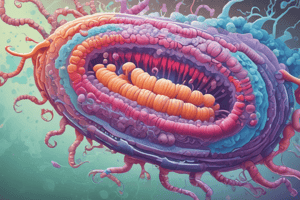Podcast
Questions and Answers
used by bacteria to attach to a host cell.
used by bacteria to attach to a host cell.
Fimbriae
locomotion
locomotion
Flagella
used to exchange genetic material during
conjugation
used to exchange genetic material during conjugation
Pilli
Single-celled microorganisms.
• Lacks an organized nucleus or any other membranebound organelle.
Single-celled microorganisms. • Lacks an organized nucleus or any other membranebound organelle.
-consist of prokaryotic cells, but if they have
cell walls, the walls lack peptidoglycan
-consist of prokaryotic cells, but if they have cell walls, the walls lack peptidoglycan
What are the three main groups of archaea?
What are the three main groups of archaea?
live in hot sulfurous water,
such as hot springs
live in hot sulfurous water, such as hot springs
live in extremely salty
environments
live in extremely salty environments
produce methane as a waste
product from respiration
produce methane as a waste product from respiration
rod shaped
rod shaped
round shape
round shape
Round to oval
Round to oval
gently curved shape to
a corkscrew-like spiral
gently curved shape to a corkscrew-like spiral
spiral but more flexible
spiral but more flexible
depend on other organism for their
food
depend on other organism for their food
synthesize their own food(rely on Co2
and other carbon molecules for energy)
synthesize their own food(rely on Co2 and other carbon molecules for energy)
obtain nutrients from dead and
decaying organic matter
obtain nutrients from dead and decaying organic matter
are thread-like, protein appendages that
enable bacteria to move.
are thread-like, protein appendages that enable bacteria to move.
share nourishment from the host
share nourishment from the host
is exhibited by organisms that feed on
a complex matter
is exhibited by organisms that feed on a complex matter
– gets nourishment from a host
– gets nourishment from a host
microorganisms that
grown in oxygen free environment.
microorganisms that grown in oxygen free environment.
oxygen is the absolute
requirement for their energy-yielding properties
oxygen is the absolute requirement for their energy-yielding properties
– they are not affected by the
presence of oxygen
– they are not affected by the presence of oxygen
they only need small amount of oxygen to generate energy
they only need small amount of oxygen to generate energy
does not entirely rely on the
availability of the oxygen in their environment instead they use
anaerobic methods to utilize ATP/energy molecules.
does not entirely rely on the availability of the oxygen in their environment instead they use anaerobic methods to utilize ATP/energy molecules.
they cannot survive in the absence of
oxygen
they cannot survive in the absence of oxygen
are thin filamentous appendages that extend from
the cell, often in the tens or hundreds. They are composed
of pilin proteins and are used by the cell to attach to surfaces.
They can be particularly important for pathogenic bacteria,
which use them to attach to host tissues
are thin filamentous appendages that extend from the cell, often in the tens or hundreds. They are composed of pilin proteins and are used by the cell to attach to surfaces. They can be particularly important for pathogenic bacteria, which use them to attach to host tissues
bundles of fibrils that arise at the ends of the
cell beneath an outer sheath and spiral
around the cell or specifically the
bundles of fibrils that arise at the ends of the cell beneath an outer sheath and spiral around the cell or specifically the
single long circular double stranded DNA
molecule devoid of highly conserved
histone protein
single long circular double stranded DNA molecule devoid of highly conserved histone protein
Whooping cough (pertussis
Whooping cough (pertussis
Nisseria gonnorhoeae?
Nisseria gonnorhoeae?
Helicobacter pyloric?
Helicobacter pyloric?
Myobacterium gordona?
Myobacterium gordona?
Bacillus cereus?
Bacillus cereus?
Bacillus anthracis?
Bacillus anthracis?
Clostridium perfringenes?
Clostridium perfringenes?
Brucellosis
Brucellosis
Genital infections, trachoma
Genital infections, trachoma
Urinary tract infections, septicemia
Urinary tract infections, septicemia
Escherichia coli!?
Escherichia coli!?
Tularemia
Tularemia
Chancroid
Chancroid
Meningitis; respiratory, ear and sinus infections
Meningitis; respiratory, ear and sinus infections
Urinary tract and respiratory infections
Urinary tract and respiratory infections
Respiratory, urinary, and wound infections
Respiratory, urinary, and wound infections
Rocky Mountain spotted fever?
Rocky Mountain spotted fever?
Typhoid fever
Typhoid fever
Rickettsia rickettsii?
Rickettsia rickettsii?
Salmonella spp
Salmonella spp
Gastroenteritis
Gastroenteritis
Plague
Plague
Cholera
Cholera
Treponema pallidum
Treponema pallidum
Tuberculosis
Tuberculosis
Leprosy (Hansen disease)
Leprosy (Hansen disease)
Flashcards
Fimbriae
Fimbriae
Hair-like appendages used by bacteria for attachment to a host cell.


